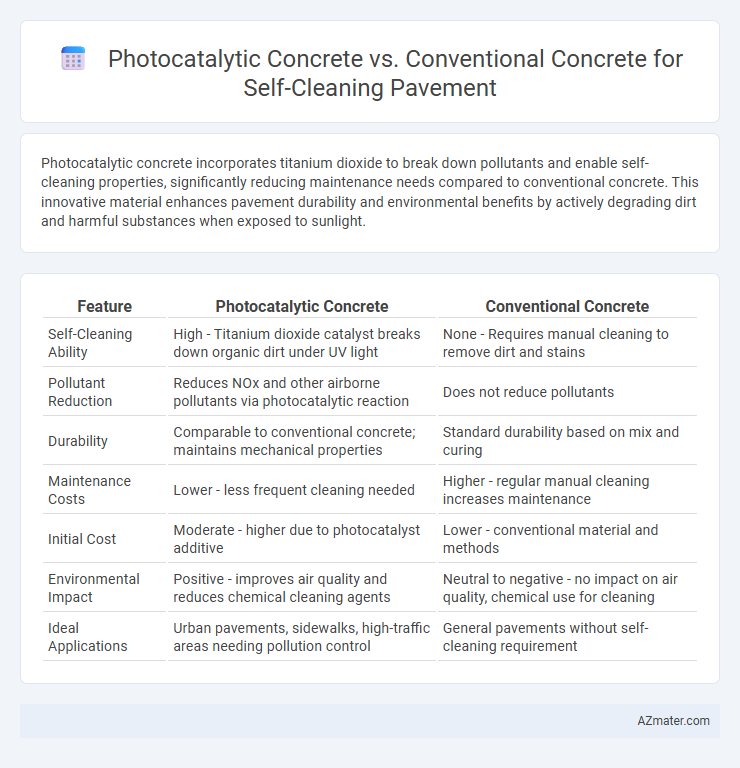Photocatalytic concrete incorporates titanium dioxide to break down pollutants and enable self-cleaning properties, significantly reducing maintenance needs compared to conventional concrete. This innovative material enhances pavement durability and environmental benefits by actively degrading dirt and harmful substances when exposed to sunlight.
Table of Comparison
| Feature | Photocatalytic Concrete | Conventional Concrete |
|---|---|---|
| Self-Cleaning Ability | High - Titanium dioxide catalyst breaks down organic dirt under UV light | None - Requires manual cleaning to remove dirt and stains |
| Pollutant Reduction | Reduces NOx and other airborne pollutants via photocatalytic reaction | Does not reduce pollutants |
| Durability | Comparable to conventional concrete; maintains mechanical properties | Standard durability based on mix and curing |
| Maintenance Costs | Lower - less frequent cleaning needed | Higher - regular manual cleaning increases maintenance |
| Initial Cost | Moderate - higher due to photocatalyst additive | Lower - conventional material and methods |
| Environmental Impact | Positive - improves air quality and reduces chemical cleaning agents | Neutral to negative - no impact on air quality, chemical use for cleaning |
| Ideal Applications | Urban pavements, sidewalks, high-traffic areas needing pollution control | General pavements without self-cleaning requirement |
Introduction to Self-Cleaning Pavement Technologies
Self-cleaning pavement technologies utilize materials like photocatalytic concrete that incorporate titanium dioxide (TiO2) to break down organic pollutants and grime through photocatalysis under UV light exposure. Conventional concrete, made primarily from cement, aggregates, and water, lacks this reactive property and depends on regular maintenance and cleaning to maintain surface cleanliness. Photocatalytic concrete enhances environmental sustainability and reduces maintenance costs by enabling pavements to degrade pollutants and resist staining autonomously.
Understanding Photocatalytic Concrete: Composition and Mechanism
Photocatalytic concrete incorporates titanium dioxide (TiO2) as a semiconductor catalyst, which activates under UV light to initiate oxidation reactions that break down organic pollutants on the pavement surface. This process allows the concrete to exhibit self-cleaning properties by decomposing dirt and harmful nitrogen oxides (NOx), improving air quality. Unlike conventional concrete, which lacks these reactive components, photocatalytic concrete maintains cleaner surfaces and contributes to environmental purification without additional maintenance.
Conventional Concrete: Properties and Limitations
Conventional concrete, widely used in pavement construction, exhibits high compressive strength, durability, and ease of fabrication, making it a reliable material for various infrastructure applications. However, its surface properties limit self-cleaning capabilities, as conventional concrete tends to accumulate dirt, pollutants, and biological growth that degrade aesthetics and functionality over time. The absence of photocatalytic properties results in higher maintenance requirements and decreased longevity in maintaining clean pavement surfaces.
Self-Cleaning Efficiency: Photocatalytic vs Conventional Concrete
Photocatalytic concrete exhibits higher self-cleaning efficiency than conventional concrete due to its titanium dioxide (TiO2) content, which activates under UV light to break down organic pollutants and reduce surface dirt accumulation. Conventional concrete lacks this photocatalytic property, resulting in slower degradation of contaminants and lower resistance to staining. Studies show photocatalytic concrete surfaces can maintain cleanliness up to 60% longer, reducing maintenance frequency for self-cleaning pavements.
Air Purification and Environmental Benefits
Photocatalytic concrete contains titanium dioxide (TiO2) that reacts with sunlight to break down pollutants such as nitrogen oxides (NOx) and volatile organic compounds (VOCs), significantly improving urban air quality. Conventional concrete lacks this photocatalytic property, offering no active air purification or pollutant degradation. The environmental benefits of photocatalytic concrete include reduced smog formation, lower greenhouse gas emissions, and enhanced sustainability through cleaner urban atmospheres and decreased pollution-related health issues.
Durability and Longevity Comparison
Photocatalytic concrete incorporates titanium dioxide nanoparticles, enhancing its resistance to pollutants and microbial growth, which significantly improves durability compared to conventional concrete. Its ability to continuously break down organic matter and prevent surface degradation extends the pavement's service life by reducing maintenance frequency. Conventional concrete often suffers from faster wear and surface contamination, leading to reduced longevity and increased repair costs over time.
Maintenance and Cost Implications
Photocatalytic concrete significantly reduces maintenance costs for self-cleaning pavements by utilizing titanium dioxide to break down organic pollutants and dirt, minimizing the need for frequent cleaning. In contrast, conventional concrete requires regular manual or chemical cleaning, increasing long-term maintenance expenses and labor efforts. Though photocatalytic concrete has a higher initial installation cost, its durability and low upkeep lead to cost savings over the pavement's lifespan.
Aesthetic Longevity and Surface Cleanliness
Photocatalytic concrete enhances aesthetic longevity by continuously breaking down organic pollutants and preventing surface stains, unlike conventional concrete, which often suffers from discoloration over time. The titanium dioxide in photocatalytic concrete actively decomposes dirt and grime when exposed to sunlight, maintaining surface cleanliness without frequent maintenance. Conventional concrete requires regular cleaning to preserve appearance, whereas photocatalytic concrete offers a sustainable, self-cleaning solution that extends pavement lifespan and visual appeal.
Real-World Applications and Case Studies
Photocatalytic concrete, utilized in urban pavements of cities like Tokyo and Milan, demonstrates significant pollutant degradation by harnessing titanium dioxide (TiO2) to break down nitrogen oxides (NOx) and organic contaminants, unlike conventional concrete which lacks this self-cleaning ability. Real-world case studies report up to 40% reduction in surface pollutants on photocatalytic concrete pavements, leading to improved air quality and decreased maintenance costs for infrastructure. The integration of photocatalytic additives shows promise in sustainable urban development, outperforming traditional concrete in durability and environmental impact mitigation.
Future Trends in Self-Cleaning Pavement Materials
Photocatalytic concrete leverages titanium dioxide to break down pollutants and organic matter, offering superior self-cleaning properties compared to conventional concrete. Future trends in self-cleaning pavement materials emphasize enhancing photocatalytic efficiency through nanotechnology and integrating smart sensors for real-time pollution monitoring. Advances in eco-friendly binders and hybrid materials aim to improve durability and sustainability while reducing maintenance costs in urban infrastructure.

Infographic: Photocatalytic concrete vs Conventional concrete for Self-cleaning pavement
 azmater.com
azmater.com